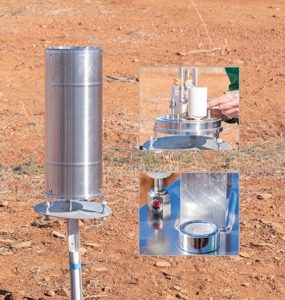A rain gauge is a device that measures rainfall by collecting the water in a graduated cylinder or funnel during a rainfall. While the basic type of rain gauge requires manual emptying, more sophisticated models utilize a tipping bucket system to continuously measure the water as it falls, preventing the measurement errors caused by evaporation. Many rain gauges also contain electronic sensors so that they can send data to a weather station. The type of rain gauge you choose will depend on your personal preference and location.
Placement
 If you’re planning to install a rain gauge, you’ll need to know where to place it to get an accurate reading. A 203-mm rain gauge is circular and collects the rain into a graduated cylinder. Its top should be placed at 0.3 meters above ground level. Avoid placing the gauge in a corner where it may face high traffic or near a building or tree. Instead, place it in a bucket, container, or hole. Then, place it in a safe, dry area, and measure the rain daily.
If you’re planning to install a rain gauge, you’ll need to know where to place it to get an accurate reading. A 203-mm rain gauge is circular and collects the rain into a graduated cylinder. Its top should be placed at 0.3 meters above ground level. Avoid placing the gauge in a corner where it may face high traffic or near a building or tree. Instead, place it in a bucket, container, or hole. Then, place it in a safe, dry area, and measure the rain daily.
Another aspect of the installation is the level of the rain gauge. The ideal location is where the gauge is at a level height, with no obstructions in the way. The rain gauge should be as level as possible to avoid wind obstructions. Ideally, the rain gauge should be four to six feet above the ground but no lower than two feet. For a convenient location, use a fence post.
Material
If you plan on using a rain gauge to measure rainfall, you should consider its placement. You can place it in a container or bucket on the ground or in a hole in a wall. In both cases, the rain gauge should be removed each day. The rain gauge should be emptied during the rainy season, and the collected water is then poured into a measuring cylinder. Some measuring cylinders are in cm, so if there is a mark on the cylinder that reads 10 cm, that means ten centimetres of rain fell that week.
The tipping bucket is one of the most important components of a rain gauge. It directly affects the instrument’s accuracy. In addition to storing the rainfall, the tipping bucket is subject to dirt and oil, so it should be cleaned periodically. To clean the inner wall of a rain gauge, rinse it with clean water, then gently brush the tip to remove any debris. A rain gauge should be cleaned at least once a month to maintain accuracy.
Opening size
The accuracy of a rain gauge depends on how accurate the measurement is. It is necessary to use a rain gauge with a minimum difference of one per cent between the recorded and real amount of rainfall. This error reflects the resolution of the rain gauge, which is a graduated cylinder with the same opening. In practice, the accuracy of a rain gauge can vary up to two per cent, but it will still be highly accurate. This type of gauge is often more expensive than others.
The best way to determine the accuracy of your rain gauge is to check it daily. It can tell you how much rain fell in the previous 24 hours. Therefore, it is important to place it over level ground. It is also important to place it at least three feet above ground level. The height of the opening will affect the accuracy of the measurement. In addition, you can place the rain gauge in a flower pot. However, it is important to choose the right height because wind flow can change the accuracy of your rain gauge.
Height from ground
The Rain gauge is a device that measures the amount of rainfall that falls on a location. A small graduated cylinder is placed inside a larger cylinder with an 8-inch diameter—the water in the receiving cylinder tips into the cylinder, and then drains into a second bucket. The rain gauge contains a calibrated measuring jar. The rain gauge is raised slightly above ground level to prevent splashing. The rainfall measurement is usually taken daily, between 0830 and 1930 hrs.
There are several challenges to estimating rainfall from a rain gauge. First, rainfall is usually quite variable, and the accuracy of rain gauge measurements is affected by many factors. One of these problems is wind-induced under catch. This phenomenon causes raindrops to be deflected away from the collecting orifice, which results in less rainfall reaching the ground level. Computational fluid dynamics models and field intercomparisons have examined the effects of this effect. In addition, the rainfall intensity and its associated turbulence have a large impact on rain gauge accuracy.
Environment
The environment of a rain gauge can be described as a spot sample of the rainfall that falls in a catchment area. The more varied the rainfall is, the more rain gauges are required. One rain gauge per twenty-five kilometres should be used for a catchment area with a significant rainfall gradient. The density of the gauges should be high enough to provide good control accuracy. However, high density may not be practicable in the first few years in some regions, such as hilly regions.
